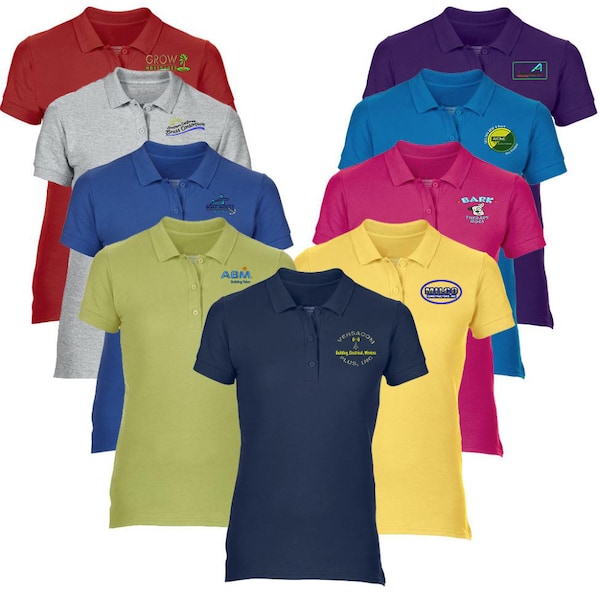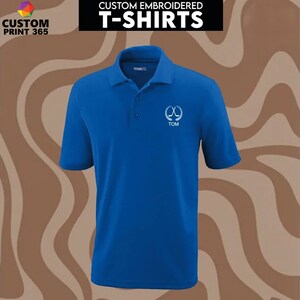Polo shirts – they're a timeless classic, versatile enough for a casual Friday at the office, a weekend golf game, or even a team uniform. But what truly elevates a good polo shirt to a great one? Custom embroidery. A well-designed logo, a catchy slogan, or a unique graphic can transform a simple garment into a powerful statement, a brand ambassador, or a cherished personal item. However, the magic of custom embroidery starts long before the needle ever touches the fabric. It begins with the perfect image – specifically, the right kind of image that can be translated into stitches.
If you're looking to personalize polo shirts, whether for your business, a sports team, an event, or just for yourself, finding high-quality custom embroidery images is your first crucial step. This article will guide you through the exciting world of digital designs, showing you where to find and download the perfect images to make your custom polo shirt vision a reality. Get ready to turn your ideas into wearable art!
The Appeal of Custom Embroidered Polo Shirts
Before we dive into where to find designs, let's briefly appreciate why custom polos are so popular. They offer a blend of professionalism and comfort, making them ideal for a wide range of uses:
- Corporate Branding: A unified, professional look for employees.
- Team Uniforms: Boosts morale and identifies team members.
- Event Merchandise: Memorable giveaways or items for sale.
- Personal Expression: Showcase your hobbies, passions, or unique style.
- Gifts: A thoughtful and personalized present for friends or family.
In each of these scenarios, the embroidery is the star. It's durable, sophisticated, and adds a premium feel that screen printing often can't match. But the quality of that embroidery hinges entirely on the quality and suitability of the design file.
Understanding Embroidery Images: What You Really Need
This is where many people get confused. You can't just take any JPG or PNG image from the internet and expect it to be embroidered directly. Embroidery machines don't read standard image files. They need specialized "embroidery files" that contain stitch data.
- Raster Images (JPG, PNG, GIF): Made of pixels. Good for photos, but not ideal for direct embroidery as they pixelate when scaled and lack stitch information.
- Vector Images (SVG, AI, EPS, PDF): Made of mathematical paths. Infinitely scalable without losing quality. These are excellent for *digitization* (the process of converting an image into an embroidery file).
- Embroidery Files (DST, PES, JEF, EXP, HUS, VP3, etc.): These are the actual files your embroidery machine uses. They contain instructions for every stitch, color change, and trim.
Our goal is to find either high-quality vector images that can be digitized, or, even better, pre-digitized embroidery files.
Where to Find and Download High-Quality Polo Shirt Embroidery Images
The internet is a treasure trove of designs, but knowing where to look for the right kind of files is key. Here are the best sources:
1. Dedicated Embroidery Design Marketplaces
These websites specialize in selling ready-to-use embroidery files. This is often the easiest route if you have an embroidery machine yourself or want to provide a specific file to your embroiderer.
- EmbroideryDesigns.com: One of the largest platforms, offering a vast array of designs categorized by theme, machine format, and size.
- Urban Threads: Known for its unique, modern, and often quirky designs. Great for personal projects or niche brands.
- OESD (Oklahoma Embroidery Supply & Design): A reputable source for high-quality, professional designs, often including collections and tutorials.
- Brother iBroidery / Husqvarna Viking / Janome (and other machine brands): Many embroidery machine manufacturers have their own design stores optimized for their specific machines.
- Etsy: A fantastic place to find independent designers selling unique, often handmade-style embroidery files. Search for "embroidery design file" or "digitized logo."
What to look for: Ensure the design is available in the file format compatible with your (or your embroiderer's) machine (e.g., DST, PES, JEF). Check the design size and stitch count to ensure it's suitable for a polo shirt (typically chest or sleeve placement).
2. Stock Image and Vector Websites
These sites are excellent for finding vector graphics that can then be sent to a professional digitizer to convert into an embroidery file. They are generally *not* for ready-to-embroider files.
- Freepik / Vecteezy: Offer a mix of free and premium vector graphics. Use search terms like "logo vector," "badge design," "corporate emblem," "sports icon," or "abstract vector art."
- Adobe Stock / Shutterstock / Getty Images: Premium platforms with millions of high-quality vector illustrations. These often come with broader licensing options for commercial use.
- Pixabay / Unsplash: Primarily for photos, but can sometimes yield simple vector icons or design elements if you filter your search carefully. More for inspiration or simple shapes.
What to look for: Prioritize SVG, AI, or EPS files. These are vector formats that are easy for digitizers to work with. Always check the licensing terms – some free designs require attribution, while paid licenses offer more flexibility.
3. Graphic Design Portfolio Sites and Communities
These platforms are less about direct downloads and more about inspiration or finding a designer to create something bespoke.
- Behance / Dribbble: Explore thousands of graphic design portfolios. You might find a style you love and can then contact the designer for a custom project or to purchase an existing design.
- Pinterest: A visual search engine that can lead you to various design resources, including free vector downloads or links to marketplaces.
What to look for: Use these for ideas. If you find a design you like, check if the designer offers it for sale or is available for custom work. Remember, you'll still need to get it digitized for embroidery.
4. Freelance Designers and Digitizing Services
If you have a unique idea or a complex logo, or if you've found a great vector graphic that needs to be converted into an embroidery file, a professional is your best bet.
- Fiverr / Upwork: Platforms where you can hire freelance graphic designers to create custom logos or digitizers to convert your existing vector files into embroidery formats.
- Local Embroidery Shops: Most professional embroiderers offer digitizing services. They can take your high-resolution image (even a good quality JPG) and convert it into an embroidery file, often including the cost in your overall order.
What to look for: When hiring a digitizer, ask for samples of their work and ensure they understand the specific requirements for polo shirt embroidery (e.g., backing, stitch density for different fabrics). Provide them with the highest quality source image you have.
Important Considerations Before Downloading and Using
Licensing and Usage Rights
This is critical. Just because you can download an image doesn't mean you can use it however you want. Always check the license:
- Personal Use: Fine for your own polo, but not for selling.
- Commercial Use: Required if you're selling the shirts or using them for a business/brand.
- Attribution: Some free licenses require you to credit the designer.
- Royalty-Free: Often means you pay once and can use it multiple times without further fees, but check specific terms.
Quality and Resolution
For vector files, ensure the lines are clean and crisp. For embroidery files, check reviews if available, and ensure the stitch density looks appropriate for the size and fabric. A poorly digitized file will result in poor embroidery.
File Formats Revisited
Double-check that the file format you're downloading is what you need. If it's a vector (SVG, AI), you'll need a digitizer. If it's an embroidery file (DST, PES), ensure it matches your machine or your embroiderer's capabilities.
Design Complexity and Size
Embroidery has limitations. Very fine details, gradients, or extremely small text can be difficult or impossible to reproduce accurately with stitches. Keep your design relatively simple for best results on a polo shirt. Also, consider the final size – a design meant for a cap might look too small on a polo chest.
Making Your Custom Polo Shirt Project a Success
Finding and downloading the right image is a huge step, but remember the overall process:
- Vision: Have a clear idea of what you want your polo to look like.
- Image Sourcing: Use the resources above to find or create your design.
- Digitization: If necessary, get your vector image professionally digitized into an embroidery file.
- Embroidery: Work with a reputable embroiderer. Provide them with the correct file and discuss fabric type, thread colors, and placement.
- Proofing: Always ask for a digital mock-up or a physical stitch-out sample before mass production.
Conclusion
Custom embroidered polo shirts offer a fantastic way to express individuality, promote a brand, or unify a team. The foundation of any successful custom polo project lies in selecting and preparing the right embroidery image. By understanding the different types of files and knowing where to look – from specialized embroidery marketplaces to general vector sites and freelance designers – you can confidently find the perfect design to bring your vision to life. Remember to always pay attention to licensing, file quality, and the crucial step of digitization. With these tips, you're well on your way to creating stunning, personalized polo shirts that stand out from the crowd.
This article covered the importance of custom embroidery on polo shirts, explained the different types of image files (raster, vector, embroidery), and provided a comprehensive guide on where to download suitable images. We explored dedicated embroidery design marketplaces, general stock image sites, graphic design communities, and the option of hiring freelance designers and digitizers. Finally, we highlighted critical considerations such as licensing, quality, file formats, and design complexity to ensure a successful custom polo shirt project.




